A PHOTO DISCUSSION ON NUTTING'S
FLYCATCHER IDENTIFICATION
text © 2003 Don Roberson
all photographs are copyrighted © 2003
by the photographers cited; used here with permission
In connection with the appearance of an interesting Myiarchus
flycatcher in urban Santa Cruz, central California, in January 2003, I
was among those asked to come observe the bird and assess whether it was
a Dusky-capped Flycatcher M. tuberculifer or something else. Steve
Gerow, the first observer asked for this opinion (i.e., the bird had been
tentatively reported as a Dusky-capped), noted a number of critical problems
with that proposed identification. At that point David Suddjian, Dan Singer,
Joe Morlan, Robbie Fischer, Rita Carratello and I were invited to visit
the private residence to help in an identification. As more fully described
elsewhere
on this web site, and on Joe
Morlan's web page, we collectively identified the bird as a Nutting's
Flycatcher M. nuttingi. The bird was viewed thereafter by hundreds
of observers, and was featured in the local Santa Cruz newspaper. It was
present 1-18 Jan 2003 and then disappeared for a week, but reappeared in
late January and is still present at this posting (5 Feb 2003). The web
pages cited above, prepared the day of our initial identification, emphasized
separation points between Nutting's and Dusky-capped Flycatcher but gave
rather short shrift to the possibility of Ash-throated Flycatcher M.
cinerascens. Separation between Nutting's and Ash-throated was long
considered difficult to impossible in the field (e.g., Dickerman &
Phillips 1953), and it was until 1961 that a full analysis showing that
two species were involved was published (Lanyon 1961). However, recent
field experience by many birders with wintering birds at Patagonia Lake
State Park, Arizona (14 Dec 1997-21 Mar 1998) and at Mason Regional Park,
Orange Co., California (11 Nov 2000-26 Mar 2001) has led to some "conventional
wisdom" about identification, and some of it now appears in newer field
guides (e.g., National Geographic 1999). These birds were much discussed,
especially the Arizona bird. Important comments by Will Russell (who found
the Arizona bird in 1997), Kimball Garrett, Chris Benesh, and Michael O'Brien
are in the archives
of the Frontiers of Bird Identification chatline. A stunning color
photo by Larry Sansone of the Arizona bird appears on the cover of Field
Notes, Vol. 52, No. 2 (1998; see also below) and more color photos
are inside (photos by Paul Buckley, commentary by Kenn Kaufman). A color
photo of the southern California bird by Brian E. Small is on the cover
of Western Birds, Vol. 32, No. 1 (2001).
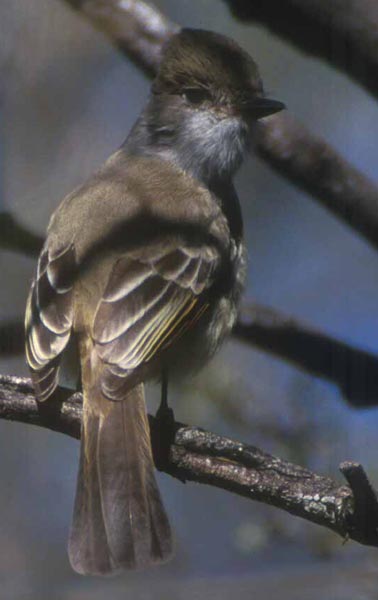
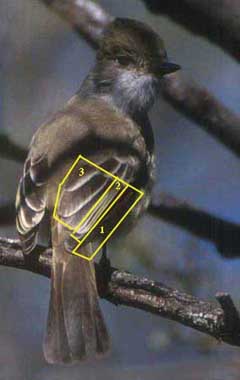 In
my initial discussion,
some ten characters were mentioned that were thought important. Now, after
a detailed review of the literature (more below), it is apparent that some
are important and others are not. Before delving into a variety of characters,
though, I want to draw attention to what I called "the classic wing-panel"
pattern with its 'yellow 'mid-panel' feature." To the far right is a wonderful
Ed Harper photo of the Patagonia Lake bird taken in Jan 1998, and a smaller
inset on which I show the three elements of the wing panel:
In
my initial discussion,
some ten characters were mentioned that were thought important. Now, after
a detailed review of the literature (more below), it is apparent that some
are important and others are not. Before delving into a variety of characters,
though, I want to draw attention to what I called "the classic wing-panel"
pattern with its 'yellow 'mid-panel' feature." To the far right is a wonderful
Ed Harper photo of the Patagonia Lake bird taken in Jan 1998, and a smaller
inset on which I show the three elements of the wing panel:
-
primary edges
-
outer secondary edges
-
tertials and inner secondary edges
In broad generalities, I see the color of the edges of three parts of the
wing in this photo of the Arizona bird as: (1) red, (2) yellow, and (3)
white. Of course, the colors are more subtle than that. "Red" is rufous,
"yellow" is a pale yellow, and "white" is whitish rather than a pure white.
In point of fact, as will be detailed below, the 'mid-panel' is not really
yellow, but a blend of colors starting as rufous, shading to cinnamon through
yellow to cream over the course of the outer four or five secondaries.
Kaufman's photo captions (Field Notes 52:148) describe this pattern
of colorful edgings as: "rufous on the primaries, changing to pale orange-buff
on the secondaries (where the Ash-throated is whitish instead)." Howell
& Webb (1994) call the primary edges "rufous," the secondary edges
"cinnamon," and the tertial edges "fawn to whitish (worn)." National Geographic
(1999) says: "rufous primary edges blend to yellow-cinnamon secondary edges.
"Lanyon (1961) says the colors are "deep rufous" on outermost secondary,
fading to "pale rufous or brownish white" to tertials that are "white or
grayish white." Nonetheless, I see a pale lemon-yellow color in the 'mid-panel'
in these photos of the Arizona bird in January (and had that impression
in the field of a 'yellow mid-panel' on the Orange County and then the
Santa Cruz County bird. It is also apparent on Larry Sansone's cover photo
of this same bird for Field Notes magazine (see below); also taken
in January. I understand that there are those who insist that the red-yellow-white
combo just described is not the pattern for Nutting's, insisting it is
closer to "red-red-white." Unfortunately, I cannot agree. I see the Nutting's
pattern, as properly understood with its gradation of colors in the 'mid-panel,'
as essentially red-yellow-white. True, the 'mid-panel' fades from red through
cinnamon (=pale orange buff?) to pale yellow. You may judge this for yourself.
In the long run, as detailed below, this debate may be semantic and irrelevant.
Yet, for purposes of discussion, and if you can yourself see the Nutting's
pattern as broadly "red-yellow-white," then we can have a discussion. Simply
put, juvenal plumage of all the Myiarchus in question can be described,
in terms of these panels, as "red-red-white" while the pattern of all Ash-throated
Flycatchers after juvenal remiges have been replaced can be described as
"red-white-white."
Thus, to summarize, in broad simple terms and subject to all the caveats
below, wing patterns of Nutting's and Ash-throated Flycatchers can be classified
into three basic types:
-
red-red-white = juvenal Ash-throated and juvenal Nutting's (also adult
Dusky-capped goes here)
-
red-white-white = post-juvenal Ash-throated
-
red-yellow-white = post-juvenal Nutting's
See if you can find these panels on the cover photo of Field Notes
(right), and see if you agree they show "red-yellow-white" in the very
broad terminology used here. |
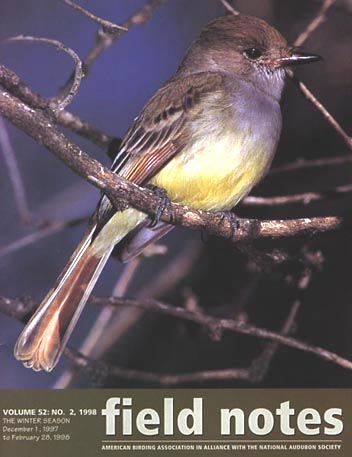 |
| These patterns can be useful to help properly age a bird in the field.
As we shall see, knowing the exact age/plumage may be critical for identification.
It is important to recognize a juvenal-plumaged bird, and to exclude the
presence of juvenal feathers (or properly understand them) on a mid-winter
Myiarchus. The bird on the far right is a juvenal Ash-throated Flycatcher,
taken in southern California on 4 Sep 1981 (© John Marchant). Note
that it not only has a "red-red-white" pattern to the wings, but that it
still possesses juvenal rectrices (all rufous with a thin brown stripe
down the shaft of the feather).
Pyle (1997) explains that molt in hatch-year Myiarchus begins
on the nesting ground, is suspended during migration, and is usually completed
on the wintering ground (there are a small percentage, ~5% of Ash-throats,
that do not complete all covert/secondary replacement until the second
basic molt). The entire tail (except, occasionally, the central rectrices)
is replaced on the summer grounds, but often secondary molt is suspended
until the winter grounds are reached. The outermost 1-4 secondaries are
often (but not always) replaced before migration, leaving inner secondaries,
next to the tertials, as unreplaced juvenal feathers. It is apparent to
me, in reading details of some Ash-throated Flycatchers that are vagrants
to eastern North America during fall migration (e.g., October into December;
see Murphy 1982), and from review of some photos of eastern vagrants, that
many juvenal secondaries have yet to be replaced even though the tail feathers
have been replaced. Lanyon (1961) describes Ash-throats with up to 4 secondaries
still retained in late November and this is on the winter grounds! It
seems logical that many fall vagrants to the East undergoing substantial
migratory movement in the wrong direction never begin secondary molt until
the ultimate winter grounds are reached. More study is needed, but this
hypothesis would explain Ash-throats in the East whose wing pattern might
be described as "red-red-white," just like this September juvenal bird. |
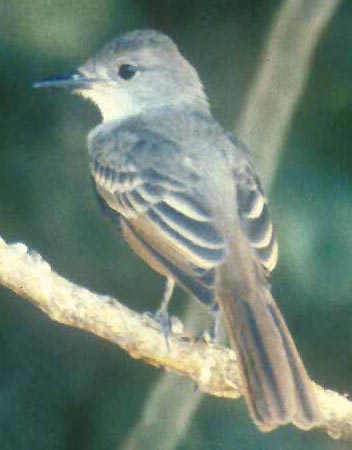 |
| SOME CAVEATS ABOUT COLOR PERCEPTION IN PHOTOS AND
ON THE WEB:
Some colors reproduce well in photos and on the web, and others do not.
People also differ in perception; there has long been problems in reaching
consensus as to where a gull's legs, for example, might fall within a yellow
to pink continuum. With reference to the Myiarchus problem, there
are problems with "pale yellow" vs. "white" and problems with "gray" vs
"brown." As to the first problem, I use as an illustration the yellow vent
strap present on the wintering Black-throated Green Warbler at Laguna
Grande at the same time as the Myiarchus in Santa Cruz, and seen by dozens
of observers. The lovely top photo (right) is by Bill Hill [more on his
web site]. Bill took this shot on Provia FX professional film with
his huge lens and a Fresnel flash. Although the pale yellow vent strap
is subtle, I find it obvious to see. In contrast, my own more distant photo
(below right) of the same bird, taken with Sensia 400 film and without
flash, puts the underparts in shadow even on a sunny day, and the vent
strap all but disappears.
There is a PhotoShop tool that can help with colors, if properly used.
On the top photo, the magenta arrows point at well-lit spots on the flanks
and in the vent strap. Using the color picker, I could then "pour" the
color the computer said in found at those spots into the numbered boxes
I created to the right. The flank color is bright white. The subtle color
in the vent strap area is not white. It is hard to describe the color
perhaps pale straw? but it is in the "pale yellow" family of colors,
as opposed to "white."
On the bottom photo, the color picker shows the head color, nicely lit,
as bright yellow. But the belly in the shade which I see as white because
we know it is white, and also because we can compensate for shadow in real
life to "see" the unshaded color, is picked as a rather medium gray by
the color picker [box #2 in the lower right corner].
Dan Singer has drawn my attention to a good
online color chart. It will be helpful as a reference in this project. |

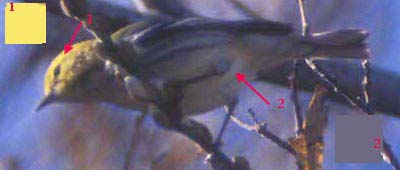 |
Using the color picker correctly may help some in evaluating photos
(and I thank Bill Hill for the idea in the first place!). It is also important
to recognize that color differences between photos of the same bird will
occur, and that some will be accounted for by differences in lens, film,
and use of flash. In general, the professional films preferred by high-end
photographers will give a more saturated color than the grainier, faster
films used by "record shot" takers like myself. I also see substantial
variation in color saturation and hue in digital shots, and some of this
is accounted for by differences in the scopes used for the "digiscoping."
Some scopes are "cool" toward blue on the color spectrum, while others
are warmer more toward red on the spectrum. Additional differences in
both film and digital photography will be the result of lighting conditions
at the time. Given these facts, I find it rather amazing that some folks
who look at web photos can claim with apparent confidence that the color
on, say, the edges of the secondaries were "white", as opposed to "pale
yellow" or "lemon yellow" (a term that implies paleness to me, but not
to everyone). A bit more on that later....
SOME OTHER KEY EXPLANATIONS ABOUT THESE PAGES and the
PHOTOS:
I was able to collect photos from a variety of photographers, and have
been doing so for years while creating a teaching and reference collection.
I am thus very grateful to Tom Grey, Ed Harper, Greg Lasley, Kevin McKereghan,
J. Van Remsen, and Larry Sansone for the use of their work. Unless otherwise
indicated, all photos shown on these pages are unedited for color, contrast,
brightness, density, and hue. Most, however, have been "sharpened" slightly
for web presentation. This PhotoShop tool is standard practice; indeed,
new versions have a "web reproduction" automatic feature that does what
I routinely do on all web photos do a slight "sharpen unsharp mask" and
make slight adjustments at both ends of the brightness/contrast scale.
I have not used any of those automatic features but have sharpened the
"mask" (i.e., the entire photo) or just portions of it. Sharpening has
no effect on color presentation at all. But it does correct the inevitable
loss of sharpness in the scanning process, restoring the photo to a near
original pristine condition.
Where I have adjusted anything that affects color, that will be explained.
On this page, for example, I have lightened the scan of the cover of Field
Notes magazine, as the scan itself came out very dark. Everything else
on this page is otherwise unretouched.
THE PURPOSE AND LAYOUT OF THESE PAGES:
In the pages linked here, I look in detail at various topics about
Nutting's Flycatcher identification in an attempt to place before you information
on the identification of the Santa Cruz Myiarchus. The technique
used is, after consulting the literature, to compare photographs of known
identity birds with the Santa Cruz individual. For these purposes, I accept
the 1997-1998 Arizona bird as a Nutting's Flycatcher, as well as the 2000-2001
Orange Co., California, bird. One obvious problem with this comparison
is that both the Nutting's Flycatchers used for comparative purposes, and
the Santa Cruz bird, are birds in January. All are reasonably fresh-plumaged
individuals. Except for the juvenal Ash-throated Flycatcher shown above
on this page (a September bird in fresh juvenal plumage), all the Ash-throated
Flycatcher photos were taken between April and early June, and are thus
somewhat more worn individuals. I have tried to take this element of bias
into account, but it is there.
Mostly I aim at putting evidence out there for you to consider, and
for you to draw your own conclusions. My own conclusion will be on a final
linked page. These pages are:
The best part about preparing a web discussion is that one learns a
whole lot of stuff you didn't know before. In trying to come to grips with
this subject, I have consulted all of the literature listed below. I have
also reviewed chat line archives on the Arizona and southern California
birds, and have discussed these problems at length with Joe Morlan, Dan
Singer, Steve Gerow, Rita Carratello, and David Suddjian. I have also reviewed
published comments by a wide variety of observers, including, but not limited
to, Chris Benesh, Kimball Garrett, Kenn Kaufman, Alvaro Jaramillo, Michael
O'Brien, Will Russell, and Joel Weintraub, plus unpublished thoughts from
others, and benefited from them all.
I am particularly grateful to the photographers who published important
shots, and/or supplied unpublished photographs for review, including Richard
Bowers, Jr., Paul A. Buckley, Rita Carratello, Cindy Cummings, Tom Grey,
W. Ed Harper, Greg W. Lasley, Peter LaTourrette, Dan Lockshaw (of Owling.com),
Kevin McKereghan, Joe Morlan, J. Van Remsen, Jr., Larry Sansone, John Sorensen,
and Joel Weintraub.
LITERATURE CITED:
-
Bowers, R.K., Jr., and J.B. Dunning, Jr. 1987. Nutting's Flycatcher (Myiarchus
nuttingi) from Arizona. Amer. Birds 41:5-10.
-
Cardiff, S.W., and D.L. Dittmann. 2000. Brown-crested Flycatcher (Myiarchus
tyrannulus) in The Birds of North America, No. 496 (A. Poole
and F. Gill, eds.). The Birds of North America, Inc., Philadelphia, PA.
-
Cardiff, S.W., and D.L. Dittmann. 2002. Ash-throated Flycatcher (Myiarchus
cinerascens) in The Birds of North America, No. 664 (A. Poole
and F. Gill, eds.). The Birds of North America, Inc., Philadelphia, PA.
-
Devillers, P. 1971. The alleged occurrence of Nutting's Flycatcher in Baja
California. Calif. Birds 2:140.
-
Dickerman, R.W., and A.R. Phillips. 1953. First United States record of
Myiarchus nuttingi. Condor 55:101-102.
-
Dittmann, D.L., and S.W. Cardiff. 2000. Let's take another look: Myiarchus
flycatchers. LOS News 193:3-10. Louisiana Ornithol. Society, Baton Rouge.
-
Howell, S.N.G., and S. Webb. 1994. Field identification of Myiarchus
flycatchers in Mexico. Cotinga 2:20-25.
-
Howell, S.N.G., and S. Webb. 1995. A Guide to the Birds of Mexico and northern
Central America. Oxford Univ. Press, New York.
-
Lanyon, W.E. 1961. Specific limits and distribution of Ash-throated and
Nutting flycatchers. Condor 63:421-449.
-
Lanyon, W.E. 1997. Great Crested Flycatcher (Myiarchus crinitus)
in
The Birds of North America, No. 300 (A. Poole and F. Gill, eds.). The Birds
of North America, Inc., Philadelphia, PA.
-
Murphy, W.L. 1982. The Ash-throated Flycatcher in the East: an overview.
Amer. Birds 36:241-247.
-
National Geographic Society. 1999. Field Guide to the Birds of North America,
3rd ed. Nat. Geogr. Soc., Washington, D.C.
-
Phillips, A.R., and W.E. Lanyon. 1970. Additional notes on the flycatchers
of eastern North America. Bird-Banding 41:190-197.
-
Pyle, P. 1997. Identification Guide to North American Birds, Part I: Columbidae
to Ploceidae. Slate Creek Press, Bolinas, CA.
-
Zimmerman, D.A. 1978. A probable Nutting's Flycatcher in southwestern New
Mexico. West. Birds 9:135-136.
TOP
GO TO MONTEREY
COUNTY PAGE
GO TO HOME PAGE
GO TO
IDENTIFICATION PAGE
GO TO BIRDING THE
WORLD PAGE
GO TO BIRD FAMILIES
OF THE WORLD
Page created 20-22 Jan 2003

 In
my initial discussion,
some ten characters were mentioned that were thought important. Now, after
a detailed review of the literature (more below), it is apparent that some
are important and others are not. Before delving into a variety of characters,
though, I want to draw attention to what I called "the classic wing-panel"
pattern with its 'yellow 'mid-panel' feature." To the far right is a wonderful
Ed Harper photo of the Patagonia Lake bird taken in Jan 1998, and a smaller
inset on which I show the three elements of the wing panel:
In
my initial discussion,
some ten characters were mentioned that were thought important. Now, after
a detailed review of the literature (more below), it is apparent that some
are important and others are not. Before delving into a variety of characters,
though, I want to draw attention to what I called "the classic wing-panel"
pattern with its 'yellow 'mid-panel' feature." To the far right is a wonderful
Ed Harper photo of the Patagonia Lake bird taken in Jan 1998, and a smaller
inset on which I show the three elements of the wing panel:



